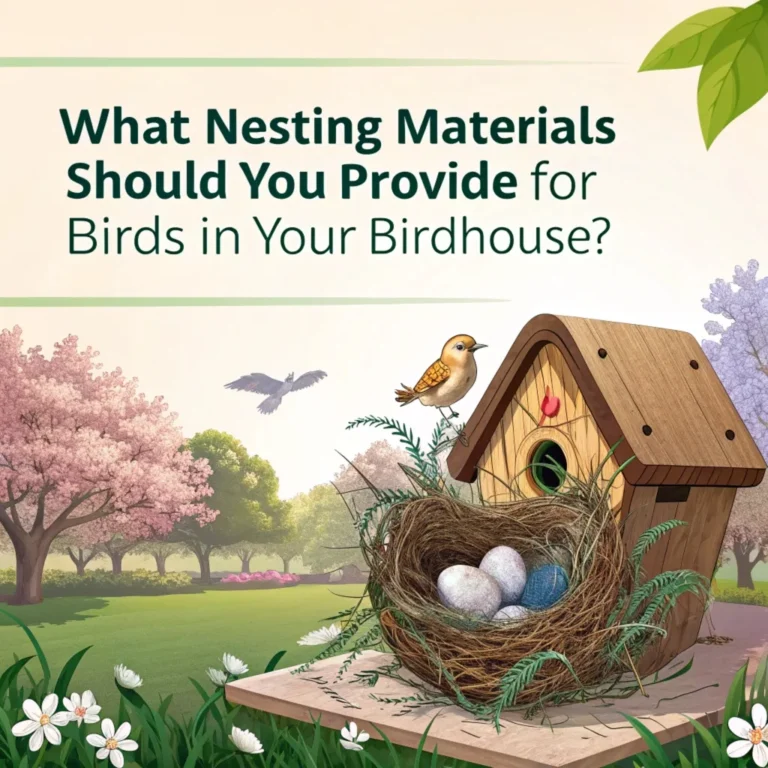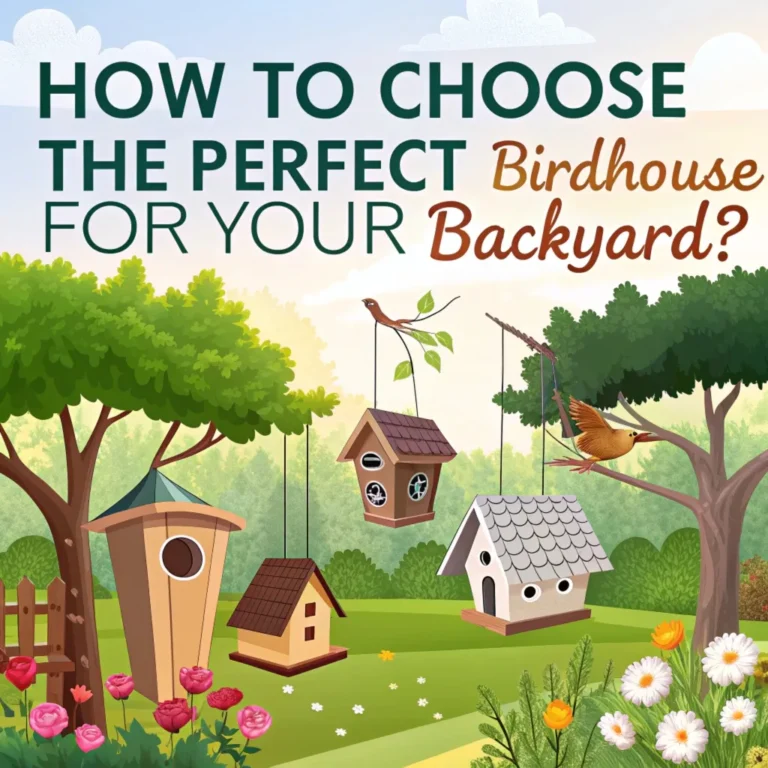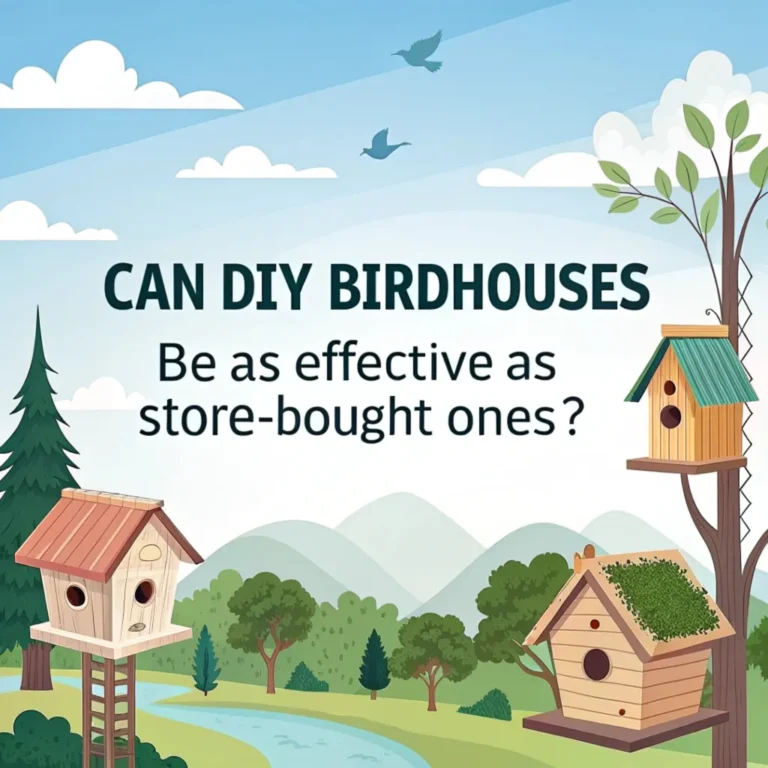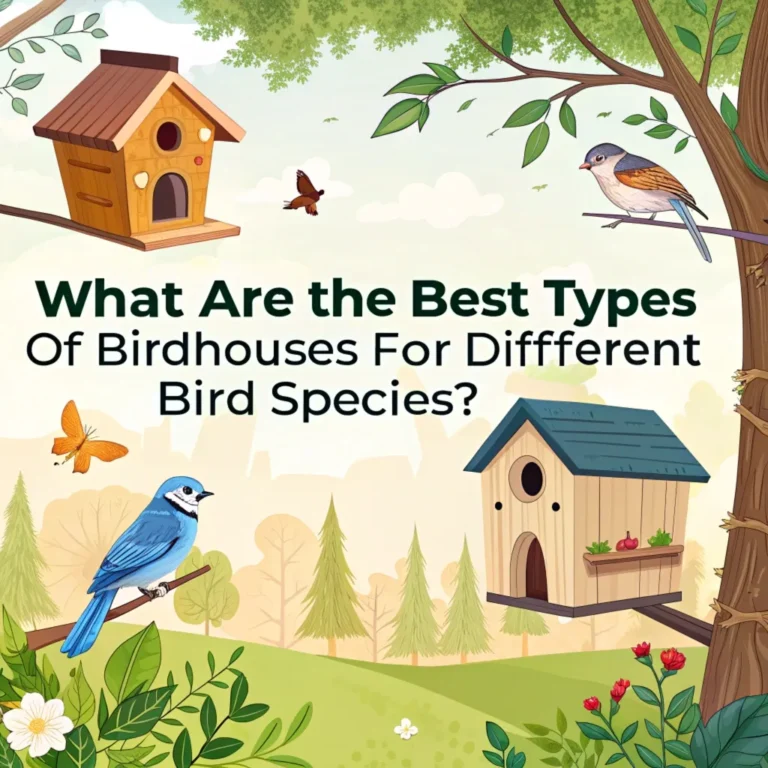What Features Should a Birdhouse Have to Be Successful? A Comprehensive Guide
Birdhouses are vital structures that provide safe nesting spaces for our feathered friends.
Creating an effective birdhouse requires careful consideration of various features to ensure it attracts birds and supports their well-being.
This guide will explore the key elements that make a birdhouse successful, helping you create the perfect home for your backyard birds.

Key Takeaways: Essential Features of a Successful Birdhouse
- Durable materials: Use untreated wood like cedar or redwood for longevity and bird safety
- Proper size: Tailor dimensions to target bird species for optimal comfort
- Ventilation and drainage: Include holes for airflow and water removal
- Secure entrance: Correctly sized hole without a perch to deter predators
- Sloped roof: Ensures rainwater runoff and protects the interior
- Easy access: Hinged panel for cleaning and monitoring
- Rough interior: Helps fledglings climb out when ready
- Natural colors: Earth tones blend with surroundings and attract birds
- Sturdy construction: Use screws and nails, not staples, for durability
- No toxic materials: Avoid treated wood, lead-based paints, or harmful chemicals
Creating a successful birdhouse involves more than just assembling a box with a hole. It requires a thoughtful approach to design, materials, and placement.
A well-crafted birdhouse not only attracts birds but also provides them with a safe and comfortable environment for nesting and raising their young. By incorporating the right features, you can create a haven for birds that will bring life and beauty to your outdoor space.
Understanding the specific needs of different bird species is crucial when designing a birdhouse. Each species has its own preferences for nesting sites, including the size of the entrance hole, the interior dimensions, and the height at which the house should be placed.
By tailoring your birdhouse to these requirements, you increase the chances of attracting a variety of birds to your yard and providing them with a suitable home.
Choosing the Right Materials
The choice of materials is crucial for a successful birdhouse. Wood is the ideal material due to its natural properties and benefits for birds. Cedar and redwood are excellent options as they are:
- Naturally decay-resistant
- Durable and long-lasting
- Good insulators
These woods can be used without paint, maintaining a natural appearance. If using pine or plywood, apply a water-based exterior latex paint to the outside for added protection.
When selecting materials for your birdhouse, it’s important to consider not only durability but also safety for the birds. Avoid using any treated woods or materials that may contain harmful chemicals.
These substances can leach into the nesting area over time, potentially harming the birds or their offspring. Stick to natural, untreated woods that provide a safe environment for nesting birds.
In addition to wood, consider using metal flashing for the roof to provide extra protection against the elements. This can help extend the life of your birdhouse and keep the interior dry during rainy weather.
Remember that the goal is to create a structure that will withstand the elements while providing a comfortable and safe space for birds to nest and raise their young.
Proper Sizing and Dimensions

The size of the birdhouse is critical for attracting specific bird species. Consider these factors:
- Floor size: Typically 4″ x 4″ or 4″ x 6″ for small to medium-sized birds
- Height: Usually 8″ to 12″, depending on the species
- Entrance hole size: Varies by species, ranging from 1″ to 3″ in diameter
Research the preferred dimensions for the bird species in your area to ensure your birdhouse meets their needs.
The interior space of a birdhouse plays a crucial role in its success. Different bird species require varying amounts of room for their nests and growing chicks.
For example, bluebirds prefer a floor space of about 5″ x 5″, while wrens can make do with a smaller 4″ x 4″ area. The height of the interior is also important, as it affects the depth of the nest and the space available for growing chicks.
When considering the entrance hole size, it’s not just about allowing the desired species to enter. The hole size also serves as a protective measure against larger predators and competing bird species.
For instance, a 1 1/8″ hole is perfect for chickadees but too small for larger birds like starlings, which can be aggressive competitors for nesting sites.
Always research the specific requirements of the bird species you want to attract to ensure your birdhouse provides the right dimensions for their comfort and safety.
Ventilation and Drainage Features
Proper air circulation and moisture control are essential for a healthy birdhouse environment. Include:
- Ventilation holes: Drill small holes near the top on opposite sides
- Drainage holes: Create openings in the bottom to prevent water accumulation
These features help regulate temperature and humidity, creating a comfortable nesting space.
The importance of proper ventilation in a birdhouse cannot be overstated. During hot summer months, the interior of a poorly ventilated birdhouse can reach dangerously high temperatures, potentially harming eggs or chicks.
By including small ventilation holes near the top of the birdhouse, you allow hot air to escape and promote air circulation. This helps maintain a more stable temperature inside the birdhouse, creating a safer environment for nesting birds.
Drainage is equally crucial for the health of nesting birds. Without proper drainage, rainwater or condensation can accumulate inside the birdhouse, leading to damp conditions that promote the growth of mold and bacteria.
These can be harmful to both eggs and chicks. By incorporating drainage holes in the bottom of the birdhouse, you ensure that any water that enters can quickly escape, keeping the interior dry and sanitary. This simple feature can significantly improve the chances of successful nesting and fledging.
Entrance Design and Predator Protection
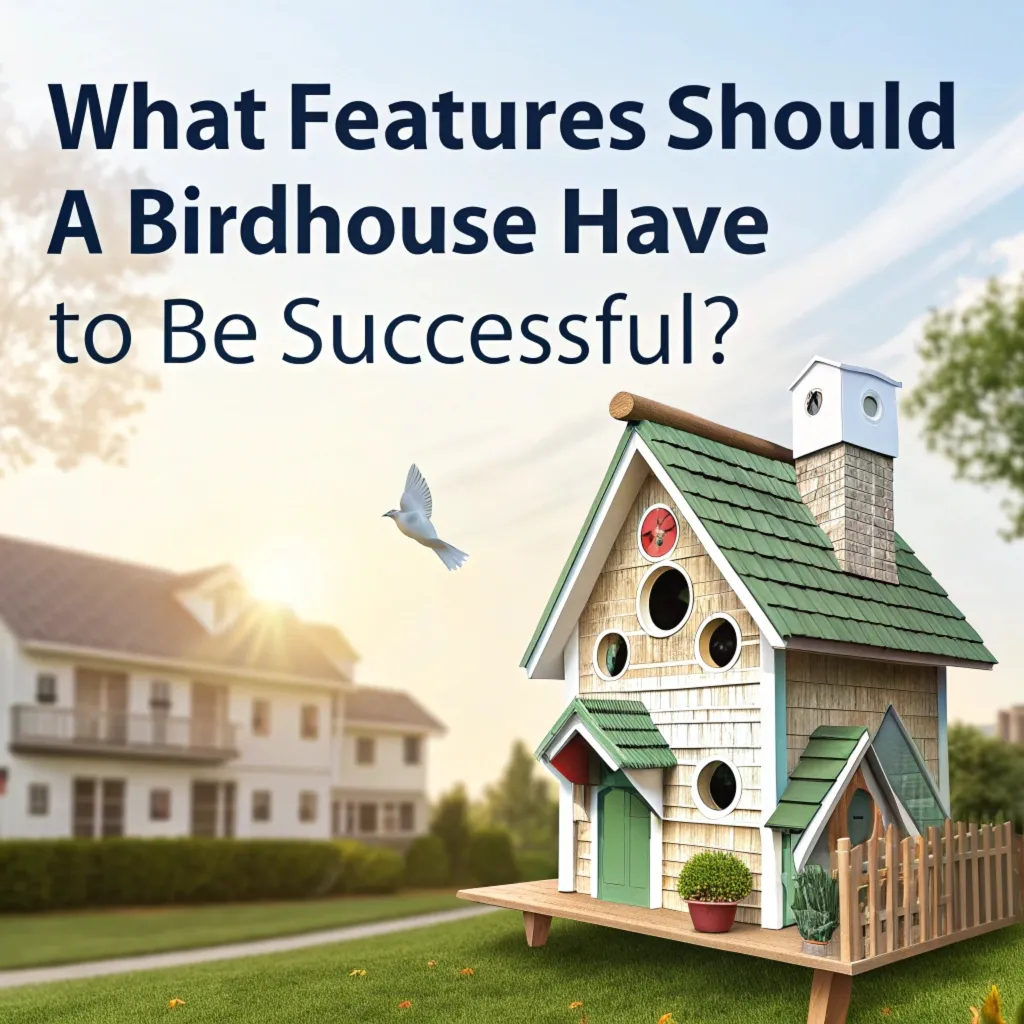
The entrance hole is a critical feature of any birdhouse. Consider these aspects:
- Size: Match the hole diameter to the target species
- No perch: Omit perches to deter predators
- Reinforced opening: Use a metal plate to prevent enlargement by predators
A properly designed entrance ensures the safety of nesting birds and their young.
The entrance design of a birdhouse is not just about allowing birds to enter; it’s a crucial element in protecting them from predators. A well-designed entrance can significantly increase the chances of successful nesting.
One important aspect is the absence of a perch. While it might seem helpful, a perch actually provides easy access for predators like raccoons or cats. Birds don’t need a perch to enter the house, but predators can use it to reach in and grab eggs or chicks.
Another key feature for predator protection is a reinforced entrance hole. Some predators, like squirrels or woodpeckers, may try to enlarge the hole to gain access.
By adding a metal plate around the entrance, you can prevent this enlargement and maintain the hole size specific to your target species.
This simple addition can make a significant difference in the safety of the nesting birds, ensuring that only the intended species can access the interior of the birdhouse.
Roof Construction and Weather Protection
A well-designed roof is crucial for protecting the birdhouse interior. Key features include:
- Sloped design: Ensures proper water runoff
- Overhang: Extend the roof 2″ beyond the entrance for added protection
- Durable material: Use weather-resistant wood or exterior-grade plywood
These elements help keep the nest dry and comfortable throughout the nesting season.
The roof of a birdhouse plays a vital role in protecting its inhabitants from the elements. A properly constructed roof not only keeps rain and snow out but also helps regulate the internal temperature of the birdhouse.
The slope of the roof is particularly important, as it allows water to run off quickly, preventing leaks and water damage. A good rule of thumb is to create a roof with at least a 15-degree angle, which provides efficient water runoff while still maintaining an aesthetically pleasing appearance.
An often overlooked feature of birdhouse roofs is the overhang. Extending the roof at least 2 inches beyond the entrance hole serves multiple purposes. First, it provides additional protection from rain, preventing water from entering the birdhouse during storms.
Second, it can offer some shade during hot summer days, helping to keep the interior cooler. Lastly, an overhang can make it more difficult for predators to reach into the entrance, adding an extra layer of security for the nesting birds.
Accessibility for Cleaning and Monitoring
Regular maintenance is essential for birdhouse longevity and bird health. Include:
- Hinged panel: Allow easy access to the interior
- Removable floor: Simplify cleaning and nest removal
- Secure closure: Ensure the access point closes tightly to prevent drafts
These features make it easy to clean and monitor the birdhouse without disturbing nesting birds.
Accessibility is a crucial aspect of birdhouse design that is often overlooked. A birdhouse that can be easily opened for cleaning and monitoring is not only more convenient for the caretaker but also healthier for the birds.
Regular cleaning helps prevent the buildup of parasites and diseases that can harm nesting birds and their offspring.
A hinged panel or removable side allows for quick and easy access to the interior, making it possible to remove old nests, clean out debris, and check on the condition of the birdhouse without causing undue stress to its inhabitants.
When designing the access point for cleaning, it’s important to ensure that it can be securely closed. A loose or ill-fitting panel can create drafts or allow water to enter the birdhouse, compromising its effectiveness as a shelter.
Consider using a simple latch mechanism or a tight-fitting design that keeps the access panel firmly in place when closed. This attention to detail in the accessibility features of your birdhouse will contribute significantly to its long-term success and the health of the birds that use it.
Interior Texture and Fledgling Support
The inside of the birdhouse should support the growth and development of young birds. Consider:
- Rough interior: Use unfinished wood or add grooves to help fledglings climb
- No paint inside: Avoid potential toxins from flaking paint
- Natural wood surface: Provides grip and mimics natural nesting sites
These features help young birds develop the strength needed to leave the nest when ready.
The interior texture of a birdhouse plays a crucial role in the development of young birds. A smooth interior might seem neat and tidy to human eyes, but it can pose significant challenges for fledglings attempting to leave the nest.
By providing a rough or textured surface inside the birdhouse, you give young birds the grip they need to climb up to the entrance hole when it’s time to fledge. This can be achieved by using unfinished wood with a natural grain or by adding shallow grooves to the interior walls.
In addition to texture, the material choice for the interior is equally important. Avoid using any paints or finishes inside the birdhouse, as these can potentially release harmful fumes or flake off over time, posing a risk to the birds.
Instead, opt for natural, untreated wood that closely mimics the conditions birds would encounter in natural nesting sites. This not only provides a safe environment but also helps young birds develop the strength and skills they need for life outside the nest.
Color and Exterior Finish
The appearance of the birdhouse can affect its attractiveness to birds and its ability to blend into the environment:
- Earth tones: Use natural colors like brown, green, or gray
- Avoid bright colors: These can attract predators and deter birds
- Natural wood finish: Consider using linseed oil for protection without paint
The right finish helps the birdhouse attract birds while remaining inconspicuous to potential threats.
When it comes to the exterior finish of a birdhouse, the goal is to create a structure that is both attractive to birds and inconspicuous to predators.
While it might be tempting to paint your birdhouse in bright, cheerful colors, this can actually deter birds and draw unwanted attention from predators.
Instead, opt for natural earth tones that blend well with the surrounding environment. Colors like brown, green, or gray can help the birdhouse camouflage with trees or foliage, making it less noticeable to potential threats.
If you prefer to maintain the natural look of the wood, consider using a protective finish like linseed oil. This natural oil penetrates the wood, providing protection against moisture and UV rays without altering the wood’s appearance significantly.
It’s important to note that any finish should be completely dry before the birdhouse is made available for nesting.
This ensures that there are no lingering fumes or tacky surfaces that could harm the birds. By choosing the right exterior finish, you can create a birdhouse that is both durable and bird-friendly.
Construction Techniques for Durability
Building a long-lasting birdhouse requires attention to construction details:
- Use screws and nails: Avoid staples for better structural integrity
- Galvanized or brass hardware: Choose rust-resistant fasteners
- Glue joints: Apply wood glue before nailing for added strength
These techniques ensure the birdhouse remains sturdy and functional for many nesting seasons.
The construction methods used in building a birdhouse can significantly impact its longevity and effectiveness. While it might be tempting to use quick and easy fastening methods like staples, these often fail to provide the long-term durability needed for a successful birdhouse.
Instead, opt for a combination of screws, nails, and wood glue to create strong, lasting joints. This approach ensures that your birdhouse can withstand years of use and exposure to the elements without falling apart or becoming unsafe for its inhabitants.
When selecting hardware for your birdhouse, consider the long-term effects of weather exposure. Choosing galvanized or brass hardware is crucial for preventing rust and corrosion, which can weaken the structure over time.
These materials are resistant to moisture and will maintain their strength even in harsh outdoor conditions.
Additionally, applying wood glue to joints before nailing or screwing them together provides an extra layer of strength and helps seal out moisture. These small details in construction can make a significant difference in the lifespan and safety of your birdhouse.
Placement and Mounting Considerations
The location and mounting of your birdhouse significantly impact its success:
- Height: Generally 5-10 feet above ground, varying by species
- Direction: Face the entrance away from prevailing winds
- Habitat: Place near appropriate vegetation for the target species
- Mounting options: Use poles, trees, or buildings depending on bird preferences
Proper placement ensures the birdhouse is attractive and accessible to nesting birds.
The placement of your birdhouse is just as important as its design and construction. Different bird species have varying preferences for nesting heights and locations.
For example, bluebirds prefer open areas and houses mounted on poles, while chickadees are more likely to use birdhouses placed in or near wooded areas.
Research the specific preferences of the bird species you’re hoping to attract and place your birdhouse accordingly. This targeted approach can significantly increase the chances of your birdhouse being occupied.
When mounting your birdhouse, consider both the safety of the birds and the stability of the structure. Ensure that the birdhouse is securely fastened to prevent it from swaying or falling during strong winds or storms.
If mounting on a tree, use a method that doesn’t damage the tree, such as a strap or removable bracket. For pole-mounted houses, consider installing a predator baffle below the house to deter climbing predators.
The direction the entrance hole faces is also important; generally, it’s best to have it face away from prevailing winds and direct sunlight to provide protection from harsh weather and overheating.
Species-Specific Adaptations
Different bird species have unique requirements for their nesting sites. Consider these adaptations:
- Bluebirds: Prefer open areas with a 1.5″ entrance hole
- Wrens: Like smaller 1″ openings near shrubs or trees
- Purple Martins: Require multi-compartment houses or gourds
Tailoring your birdhouse to specific species increases the likelihood of attracting diverse birds to your yard.
Understanding and implementing species-specific adaptations in your birdhouse design can significantly increase its appeal to your target bird species.
Each type of bird has evolved to prefer certain nesting conditions, and replicating these in your birdhouse can make it much more attractive.
For example, wood ducks prefer larger houses with entrance holes about 4 inches in diameter, while chickadees are content with much smaller spaces and entrance holes as small as 1 1/8 inches.
By researching and incorporating these specific preferences, you can create a birdhouse that is more likely to be chosen by the species you wish to attract.
In addition to size and entrance hole dimensions, consider other species-specific features. For instance, purple martins are colonial nesters and prefer multi-compartment houses or clusters of individual gourds.
Barn swallows, on the other hand, prefer open-fronted shelves rather than enclosed houses. Some species, like woodpeckers, prefer houses filled with wood chips to mimic their natural nesting habits in tree cavities.
By tailoring these details to your target species, you create a more inviting environment that closely resembles their natural nesting preferences.
Maintenance and Seasonal Care
Regular upkeep is crucial for a successful birdhouse:
- Annual cleaning: Remove old nests and debris after the breeding season
- Repairs: Check for and fix any damage before each nesting season
- Monitoring: Observe activity to ensure the birdhouse remains safe and functional
Proper maintenance helps ensure the longevity of your birdhouse and the health of its inhabitants.
Maintaining your birdhouse is an ongoing responsibility that plays a crucial role in its long-term success. After each breeding season, typically in late fall or early winter, it’s important to clean out the birdhouse thoroughly.
This involves removing old nests, droppings, and any parasites that may have accumulated. Cleaning not only prepares the house for the next nesting season but also helps prevent the spread of diseases among bird populations.
Use a solution of one part bleach to nine parts water to disinfect the interior, and ensure the birdhouse is completely dry before closing it up.
In addition to cleaning, regular inspections and repairs are essential. Before each nesting season, carefully examine your birdhouse for any signs of damage or wear. Check for loose boards, cracks, or holes that may have developed over time.
Repair any issues promptly to ensure the birdhouse remains a safe and secure nesting site. Pay special attention to the roof, as water leaks can be particularly detrimental to nesting success.
By maintaining your birdhouse diligently, you provide a reliable and healthy environment for birds year after year, contributing to the conservation of local bird populations.
FAQs
What is the best material for building a birdhouse?
Cedar and redwood are ideal materials for birdhouses due to their natural decay resistance and insulating properties.
How often should I clean my birdhouse?
Clean your birdhouse annually, typically in late fall or early winter after the breeding season has ended.
Can I paint my birdhouse bright colors?
It’s best to avoid bright colors and stick to earth tones or natural wood finishes to attract birds and avoid drawing attention from predators.
Do birdhouses need perches?
No, birdhouses do not need perches. In fact, perches can make it easier for predators to access the nest and should be avoided.
What size should the entrance hole be?
The entrance hole size depends on the target species, but generally ranges from 1 inch to 3 inches in diameter.
How high should I mount my birdhouse?
Most birdhouses should be mounted 5 to 10 feet above the ground, but the ideal height varies by species.
Can I use treated wood for my birdhouse?
No, avoid using treated wood as it can contain chemicals harmful to birds. Use untreated, naturally decay-resistant woods instead.
How do I protect my birdhouse from predators?
Use predator guards, ensure the entrance hole is the correct size, and avoid perches to help protect nesting birds from predators.
Should I provide nesting materials in the birdhouse?
Generally, it’s best to let birds gather their own nesting materials. However, you can place suitable materials near the birdhouse for them to use.
How can I make my birdhouse last longer?
Use durable materials, apply a natural wood preservative like linseed oil, ensure proper drainage, and perform regular maintenance to extend the life of your birdhouse.
By incorporating these essential features and following proper maintenance practices, you can create a successful birdhouse that provides a safe and comfortable home for your local bird population.
Remember that each species has unique requirements, so tailor your birdhouse design to the specific needs of the birds in your area.
With patience and attention to detail, you’ll soon have a thriving bird community in your backyard, contributing to local biodiversity and enjoying the beauty of nature up close.

Luna is the passionate founder and author of Birds and You, a website dedicated to sharing her love for birds with fellow enthusiasts. Through her engaging articles and guides, she aims to educate and inspire others to explore the fascinating world of birds. When she’s not writing, you can find Luna observing birds in their natural habitats or sharing beautiful bird photography on Pinterest. Join her on this journey to celebrate and protect our feathered friends!



